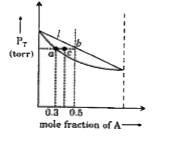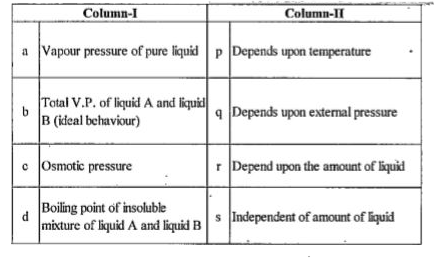Statement 1: 0.1M solution of NaCl has greater osmotic pressure than 0.1M solution of glucose at same temperature.
Statement 2: In solution, NaCl dissociates to produce more number of particles.Solution in Malayalam
Statement 1 is True, Statement 2 is true, Statement 2 is correct explanation for Statement 1
Statement 1 is True, Statement 2 is True, Statement 2 is NOT a correct explanation for Statement 1
Statement 1 is True, Statement 2 is False
Statement 1 is False, Statement 2 is True
The correct Answer is:A
For NaCl,i=2, while for glucose, i=l. Hence, osmotic pressure of NaC is higher than that of glucose solution.
Topper's Solved these Questions
- SOLUTIONSBook:BRILLIANT PUBLICATIONChapter:SOLUTIONSExercise:Level-III (Linked Comprehension Type)
Explore 12 Videos
- SOLUTIONSBook:BRILLIANT PUBLICATIONChapter:SOLUTIONSExercise:Level-III (Matching Column Type)
Explore 5 Videos
- SOLID STATEBook:BRILLIANT PUBLICATIONChapter:SOLID STATEExercise:LEVEL-3 (Linked Comprehension Type)
Explore 10 Videos
- STEREOCHEMISTRY Book:BRILLIANT PUBLICATIONChapter:STEREOCHEMISTRY Exercise:LEVEL-II (ASSERTION - REASON TYPE)
Explore 2 Videos
Similar Questions
1 mole of A and 1 mole B are mixed together to form an ideal solution at 25∘C. Solution is placed in a vessel fitted with piston. If pressure on the solution is reduced isothermally.

Correct relationship between P∘AandP∘B is
View SolutionMatch the columns

View SolutionF centre is an example of metal excess defect due to the presence of extra cations at interstitial sites. Zinc oxide is white in colour at room temperature, on heating it loses oxygen and turns yellow.
ZnOHeat−−→Zn2++12O2+2e−
Now there is excess of zinc in the crystal and its formula becomes Zn1+x O. the excess of Zn2+ ions move to interstitial sites and the electrons to neighbouring interstitial sites.
There are many solids which are difficult to prepare in the stiochiometric composition and contain less amount of the metal as compared to stiochiometric proportion. a typical example of this type is FeO which is mostly found with a composition of Fe0.95. it may actually range from Fe0.96 O.
Q. In Fe0.95 O:
View SolutionAssertion : Meso tartaric acid is optically inactive
Reason : Meso tartaric acid has a plane of symmetry
View SolutionAssertion (A): 0.1M solution of NaCl has greater osmotic pressure than 0.1Msolution of glucose at same temperature.
Reason (R ): In solution, NaCl dissociates to produce more number of particles.
View SolutionOsmotic pressure of 0.1M solution of NaCl and NaSO_(4) will be
View SolutionStatement-I: 0.1M solution of NaCI has greater osmotic pressure than 0.1M solution of glucose at same temperature.
Because
Statement-II: In solution, NaCI dissociates to produce more number of particles.
View Solutionकथन
समान ताप पर 1 M NaCl विलयन का परासरण दाब 1 M ग्लूकोज विलयन से उच्च होता है ।
कारण
1 M NaCl विलयन में उपस्थित कणो की संख्या 1 M ग्लूकोज विलयन में उपस्थित कणो की संख्या से अधिक होती है तथा परासरण दाब विलयन में उपस्थित कणो की संख्या पर निर्भर करता है ।
View Solution0.1MNaCl के घोल का परासरण दाब 0.1M ग्लूकोज घोल के परासरण दाब से कम होगा .
View SolutionAssertion: 1 M solution of KCl has greater osmotic pressure than 1 M solution of glucose at the same temperature Reason :In solution KCl dissociates to produce more number of particles .
View SolutionThe osmotic pressures of 0.1M glucose and 0.1M NaCl solutions are __________ .
View Solutionकथन 1 : 0.1M शर्करा विलयन का वाष्प दाब 0.1M KCl विलयन से अधिक होता है।
कथन 2 : विलयन में उपस्थित स्पीशीज की संख्या वाष्पदाब में कमी के अनुक्रमानुपाती होती है।
View SolutionAssertion: 0.1M glucose, 0.1M urea solutions cause the same osmotic pressure in solution.
Reason: Osmotic pressure is a measure of the number of particles present in the solution
View SolutionThe osmotic pressures of 0.1M glucose and 0.1M NaCl solutions are __________ .
View SolutionThe osmotic pressures of 0.1M glucose and 0.1M NaCl solutions are __________ .
View SolutionAssertion: 1 M solution of KCl has greater osmotic pressure than 1 M solution of glucose at the same temperature Reason :In solution KCl dissociates to produce more number of particles .
View Solution